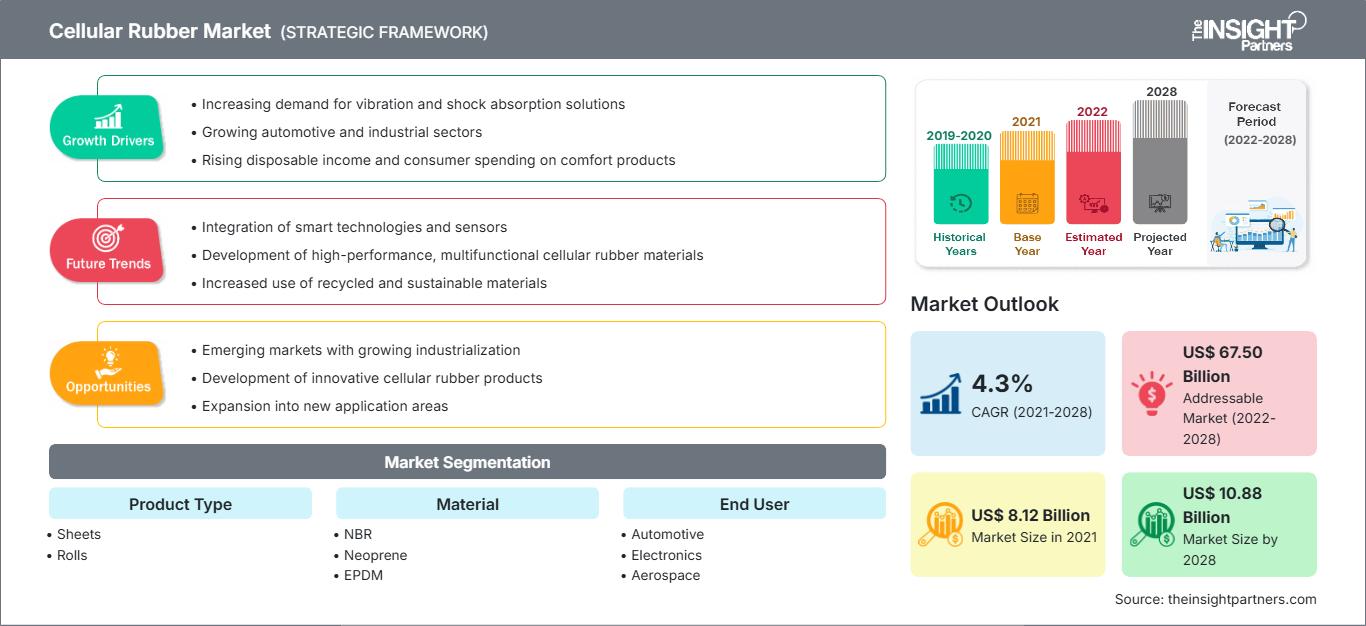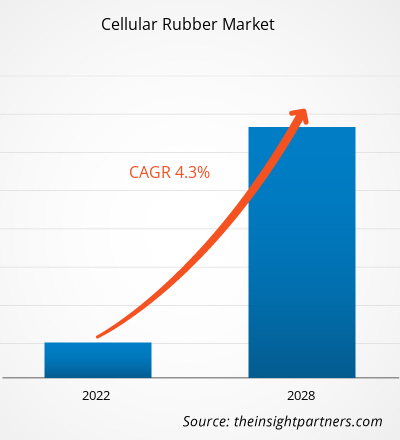Der Markt für Zellkautschuk wurde im Jahr 2021 auf 8.115,83 Millionen US-Dollar geschätzt und soll bis 2028 10.884,41 Millionen US-Dollar erreichen; von 2021 bis 2028 wird ein durchschnittliches jährliches Wachstum von 4,3 % erwartet.
Zellkautschuk ist eine Art Schaumgummi mit einer Zellstruktur, bei der die Zellen nicht miteinander verbunden sind. Er ist leicht und komprimierbar, und die Gummiplatte wird im Allgemeinen mit mikroporösen Zellen kombiniert, um die mikrozelluläre Gummiplatte zu erzeugen. Diese Gummiplatten werden häufig zur Herstellung von Schuh- und Pantoffelsohlen verwendet und sind in erster Linie auf Komfort, Flexibilität und Haltbarkeit ausgelegt. Zellkautschuk wird in der Automobilindustrie für eine Vielzahl von Anwendungen eingesetzt, darunter zum Abdichten von Türen und Schläuchen, zur Reifenherstellung und zum Schutz von Karosserieteilen vor rauen Witterungsbedingungen.
Europa wird im Prognosezeitraum voraussichtlich den größten Anteil am Zellkautschukmarkt halten. Der kontinuierliche Fortschritt der Automobilbranche in dieser Region dürfte das Wachstum des Zellkautschukmarktes in dieser Region ankurbeln. Die wachsende Nachfrage nach Autos in der gesamten Region ist hauptsächlich auf die steigende Kaufkraft der Verbraucher, die zunehmende Zahl von Familien mit Doppelverdienern, das Wachstum der Arbeiterklasse und das schnelle Wirtschaftswachstum der Länder zurückzuführen. Zellkautschuk wird aufgrund seiner Dichtungs- und Geräuschreduzierungseigenschaften zunehmend im Automobilsektor eingesetzt. EPDM-Zellkautschuk verbindet sich schnell mit Metall und wirkt als wirksamer Schutz vor Witterungseinflüssen; er schützt Fahrzeugteile außerdem vor Umwelteinflüssen, Straßenbelägen und Vibrationen.
Eine unterbrochene Versorgung mit Rohstoffen wie Polyethylen und Polypropylen, die die Produktionsprozesse beeinträchtigte, war ein Hauptfaktor, der das Wachstum des Zellkautschukmarktes während der COVID-19-Pandemie einschränkte. Darüber hinaus führte ein Anstieg der Rohölpreise zu Schwankungen der Rohstoffpreise und behinderte das stetige Marktwachstum. Der Zellkautschukmarkt verzeichnet jedoch eine kontinuierliche Nachfrage aus Endverbraucherbranchen wie der Automobil-, Bau-, Heizungs-, Lüftungs- und Klimatechnik sowie der Konsumgüterindustrie. Darüber hinaus planen mehrere Branchen im Rahmen der wirtschaftlichen Erholung strategische Investitionen in fortschrittliche und biobasierte Materialien wie Zellkautschuk, um dem wachsenden Bedarf an umweltfreundlichen Produkten gerecht zu werden. Die Automobilbranche gewinnt zunehmend an Dynamik und dürfte in den kommenden Jahren mit dem zunehmenden Absatz von Elektrofahrzeugen deutlich wachsen, was den Akteuren im Zellkautschukmarkt letztendlich erhebliche Wachstumschancen bietet. Darüber hinaus ist die Nachfrage nach verschiedenen Medikamenten und COVID-19-Impfstoffen während der COVID-19-Pandemie weltweit stark gestiegen. Der Handel dieser Branchen treibt den Bedarf an geeigneten Lagereinrichtungen und -systemen voran, was letztendlich die Nachfrage nach Zellkautschuk als Dichtungs- und Isoliermaterial weiter ankurbelt.
Passen Sie diesen Bericht Ihren Anforderungen an
Sie erhalten kostenlos Anpassungen an jedem Bericht, einschließlich Teilen dieses Berichts oder einer Analyse auf Länderebene, eines Excel-Datenpakets sowie tolle Angebote und Rabatte für Start-ups und Universitäten.
Markt für Zellkautschuk: Strategische Einblicke

-
Holen Sie sich die wichtigsten Markttrends aus diesem Bericht.Dieses KOSTENLOSE Beispiel umfasst Datenanalysen, die von Markttrends bis hin zu Schätzungen und Prognosen reichen.
Markteinblicke
Steigende Nachfrage nach Zellkautschuk in der Automobilindustrie
Die Automobilindustrie ist aufgrund seiner vorteilhaften Eigenschaften wie Abdichtung, Abschirmung und hohe Kompressibilität einer der wichtigsten Endverbraucher von Zellkautschuk. In Autos wird Zellkautschuk hauptsächlich in Dichtungen von Heizungs-, Lüftungs- und Klimasystemen, Vergaserdichtungen, Geräusch-, Vibrations- und Oberschwingungsdämpfern, Kabelbaumdichtungen, Beleuchtungsdichtungen (innen und außen), Antennendichtungen sowie Kofferraum- und Türdichtungen verwendet. Obwohl die Automobilindustrie seit langem eine lukrative Branche ist, wurde sie von der COVID-19-Pandemie hart getroffen. Die zunehmende Verbreitung von Elektrofahrzeugen und die bevorstehende Erholung der Automobilindustrie von den Auswirkungen der Pandemie bis 2022 kurbeln die Automobilproduktion an, was wiederum die Nachfrage nach Zellkautschuk antreibt. Der asiatisch-pazifische Raum ist ein bedeutender Automobilmarkt mit dem größten Anteil an der Automobilproduktion, insbesondere in China, Japan und Indien. Darüber hinaus steigt die Nachfrage nach Elektrofahrzeugen weltweit stark an. Laut den Berichten von EVAdoption wird der Absatz dieser Fahrzeuge in den USA von 507.710 Einheiten im Jahr 2020 auf 3.000.000 Einheiten bis 2028 steigen.
Produkttyp-Einblicke
Basierend auf dem Produkttyp ist der globale Zellkautschukmarkt in Platten, Rollen und sonstige Produkte unterteilt. Das Plattensegment wird im Prognosezeitraum voraussichtlich den größten Marktanteil halten. Zellkautschuk ist eine Art Schaumgummi mit einer Zellstruktur, bei der die Zellen nicht miteinander verbunden sind. Er ist leicht und komprimierbar, und die Gummiplatte wird in der Regel mit mikroporösen Zellen kombiniert, um die Mikrozellkautschukplatte herzustellen. Zellkautschukplatten finden aufgrund ihrer einfachen Handhabung und ihrer effektiven Isolierung Anwendung in Branchen wie der Automobil-, Luft- und Raumfahrt- und Elektronikindustrie. Sie eignen sich auch ideal für Dichtungs- und Schutzzwecke. Zellkautschukplatten werden aus verschiedenen Materialien wie NBR, Neopren und EPDM hergestellt und sind in verschiedenen Größen und Stärken erhältlich. EPDM-Zellkautschukplatten werden aufgrund ihrer hervorragenden Beständigkeit gegen Alterung, Witterungseinflüsse, Ozon, Sauerstoff und andere Chemikalien häufig als Dichtungen gegen Flüssigkeiten, Aluminium- und Holzfenster sowie Türrahmen verwendet.
Materialeinblicke
Basierend auf dem Material ist der globale Zellkautschukmarkt in Nitril-Butadien-Kautschuk (NBR), Neopren, Ethylen-Propylen-Dien-Monomer-Kautschuk (EPDM), Silikon und andere segmentiert. Es wird erwartet, dass das EPDM-Segment im Prognosezeitraum den größten Marktanteil halten wird. EPDM ist ein synthetischer Kautschuk aus Rohöl, der durch die Polymerisation von drei Monomeren synthetisiert wird. Geschlossenzelliger EPDM-Kautschuk eignet sich für Hochdruckanwendungen. Er ist beständig gegen Feuchtigkeit, UV-Strahlung und Ozon. Dies macht EPDM zu einem beliebten Elastomer für Anwendungen wie Fensterdichtungen in Fahrzeugen und Häusern.
Einblicke für Endverbraucher
Basierend auf dem Endverbraucher ist der globale Zellkautschukmarkt in die Bereiche Automobil, Elektronik, Luft- und Raumfahrt und Sonstige unterteilt. Es wird erwartet, dass das Automobilsegment im Prognosezeitraum den größten Marktanteil halten wird.
Zellkautschuk wird zum Abdichten von Türen und Rohren und zur Herstellung von Reifen für die Automobilbranche verwendet; er schützt auch Karosserieteile vor extremen Wetterbedingungen. Er wird unter anderem auch zur Herstellung von Karosserie- und Fahrwerksteilen verwendet. EPDM-Zellkautschuk wird in der Automobilindustrie häufig aufgrund seiner Dichtungs- und Geräuschdämmungseigenschaften verwendet. Die im Zellkautschuk vorhandenen EPDM-Bindungen verbinden sich mit Metallen und bilden so eine starke Barriere gegen Wetter und Umwelt, Straßenoberflächen und Motorvibrationen. EPDM ist außerdem UV-beständig und wasserdicht. Die Vielseitigkeit von EPDM-Zellkautschuk ermöglicht seinen Einsatz in verschiedenen Automobilanwendungen.NDS-Seals, PANA Foamtec GmbH, ERIKS, Ridderflex, Polymax Ltd, Rogers Corporation, W. KÖPP GmbH & Co. KG, SEDO Chemicals Neoprene GmbH, Kautschuk- und Kunststoffteile GmbH und Oskar Pahlke GmbH gehören zu den etablierten Akteuren auf dem Zellkautschukmarkt. Unternehmen auf dem Markt verfolgen Strategien wie Produktentwicklung, Werkserweiterungen sowie Fusionen und Übernahmen, um ihre Präsenz weltweit auszubauen und die wachsende Nachfrage der Endverbraucher zu befriedigen.
Markt für Zellkautschuk
Die Analysten von The Insight Partners haben die regionalen Trends und Faktoren, die den Zellkautschukmarkt im Prognosezeitraum beeinflussen, ausführlich erläutert. In diesem Abschnitt werden auch die Marktsegmente und die geografische Lage in Nordamerika, Europa, Asien-Pazifik, dem Nahen Osten und Afrika sowie Süd- und Mittelamerika erörtert.Umfang des Marktberichts über Zellkautschuk
Dichte der Marktteilnehmer für Zellkautschuk: Verständnis ihrer Auswirkungen auf die Geschäftsdynamik
Der Markt für Zellkautschuk wächst rasant. Die steigende Nachfrage der Endverbraucher ist auf Faktoren wie veränderte Verbraucherpräferenzen, technologische Fortschritte und ein stärkeres Bewusstsein für die Produktvorteile zurückzuführen. Mit der steigenden Nachfrage erweitern Unternehmen ihr Angebot, entwickeln Innovationen, um den Bedürfnissen der Verbraucher gerecht zu werden, und nutzen neue Trends, was das Marktwachstum weiter ankurbelt.

- Holen Sie sich die Markt für Zellkautschuk Übersicht der wichtigsten Akteure
Berichts-Spotlights
- Fortschreitende Branchentrends auf dem Zellkautschukmarkt sollen Akteuren bei der Entwicklung effektiver langfristiger Strategien helfen
- Geschäftswachstumsstrategien in entwickelten und sich entwickelnden Märkten
- Quantitative Analyse des Zellkautschukmarktes für den Zeitraum 2019–2028
- Schätzung der Nachfrage nach Zellkautschuk in verschiedenen Branchen
- Jüngste Entwicklungen zum Verständnis des Wettbewerbsmarktszenarios und der Nachfrage nach Zellkautschuk
- Markttrends und -aussichten sowie Faktoren, die das Wachstum des Zellkautschukmarktes bestimmen
- Verständnis der Strategien, die das kommerzielle Interesse im Hinblick auf das Wachstum des globalen Zellkautschukmarktes untermauern
- Detaillierter Überblick und Segmentierung des globalen Zellkautschukmarktes sowie seiner Dynamik in der Branche
- Größe des Zellkautschukmarktes in verschiedenen Regionen mit vielversprechenden Wachstumschancen
Der Bericht soll einen Überblick über den Markt mit detaillierter Marktsegmentierung geben basierend auf Produkttyp, Material, Endverwendung und Geografie. Basierend auf dem Produkttyp ist der Zellkautschukmarkt in Platten, Rollen und Sonstiges segmentiert. Basierend auf dem Material ist der Zellkautschukmarkt in NBR, Neopren, EPDM, Silikon und Sonstiges segmentiert. Basierend auf dem Endbenutzer ist der Markt in Automobil, Elektronik, Luft- und Raumfahrt und Sonstiges segmentiert. Basierend auf der Geografie ist der Zellkautschukmarkt in fünf Hauptregionen segmentiert: Nordamerika, Europa, Asien-Pazifik, Naher Osten und Afrika sowie Süd- und Mittelamerika.
Firmenprofile
- NDS-SEALS
- Pana Foamtec GmbH
- Eriks
- Ridderflex
- Polymax Ltd
- Rogers Corporation
- W. KÖPP GmbH & Co. KG
- SEDO Chemicals Neoprene GmbH
- Kautschuk- und Kunststoffteile GmbH.
- Oskar Pahlke GmbH
- Historische Analyse (2 Jahre), Basisjahr, Prognose (7 Jahre) mit CAGR
- PEST- und SWOT-Analyse
- Marktgröße Wert/Volumen – Global, Regional, Land
- Branchen- und Wettbewerbslandschaft
- Excel-Datensatz
Aktuelle Berichte
Verwandte Berichte
Erfahrungsberichte
Grund zum Kauf
- Fundierte Entscheidungsfindung
- Marktdynamik verstehen
- Wettbewerbsanalyse
- Kundeneinblicke
- Marktprognosen
- Risikominimierung
- Strategische Planung
- Investitionsbegründung
- Identifizierung neuer Märkte
- Verbesserung von Marketingstrategien
- Steigerung der Betriebseffizienz
- Anpassung an regulatorische Trends






















 Kostenlose Probe anfordern für - Markt für Zellkautschuk
Kostenlose Probe anfordern für - Markt für Zellkautschuk